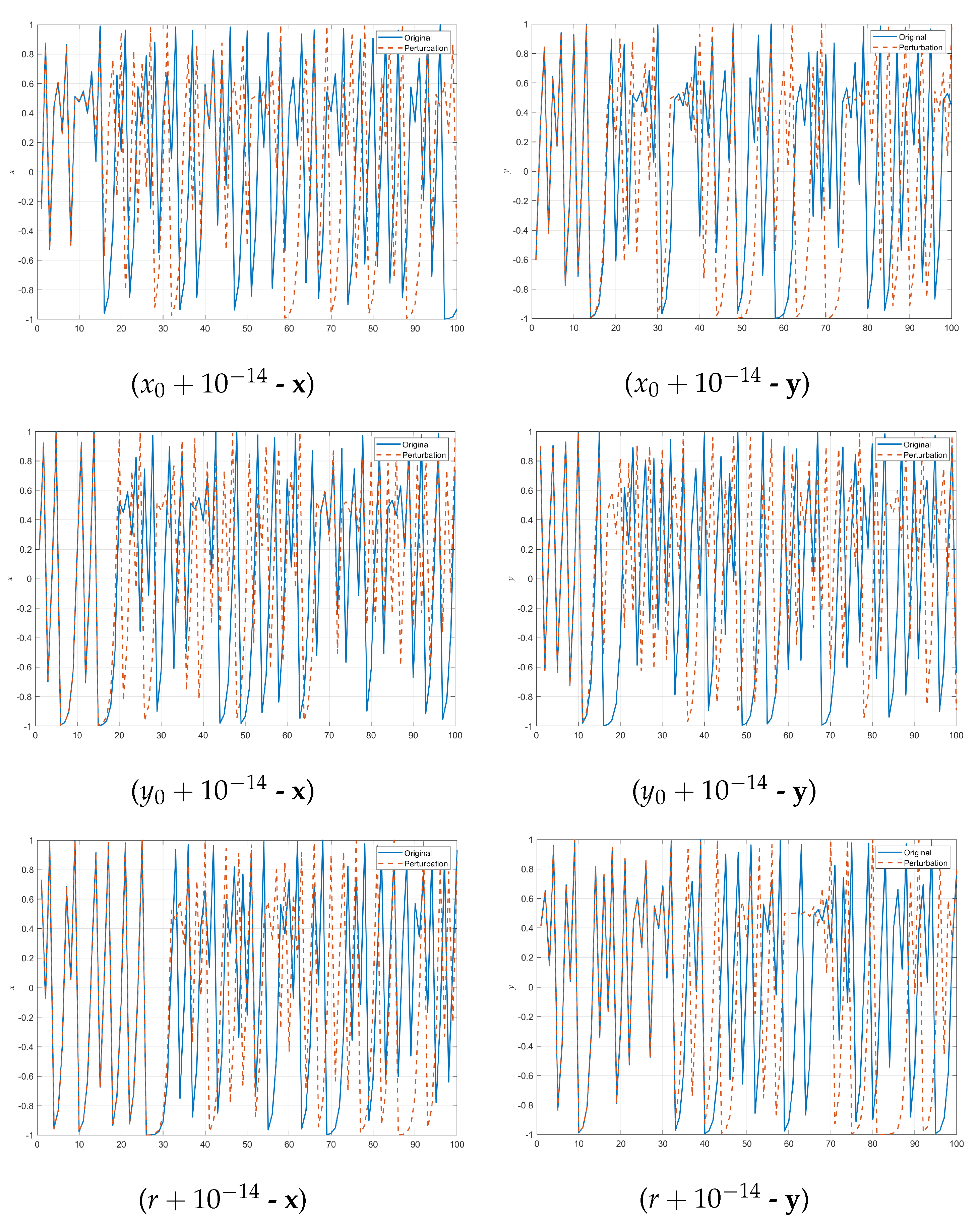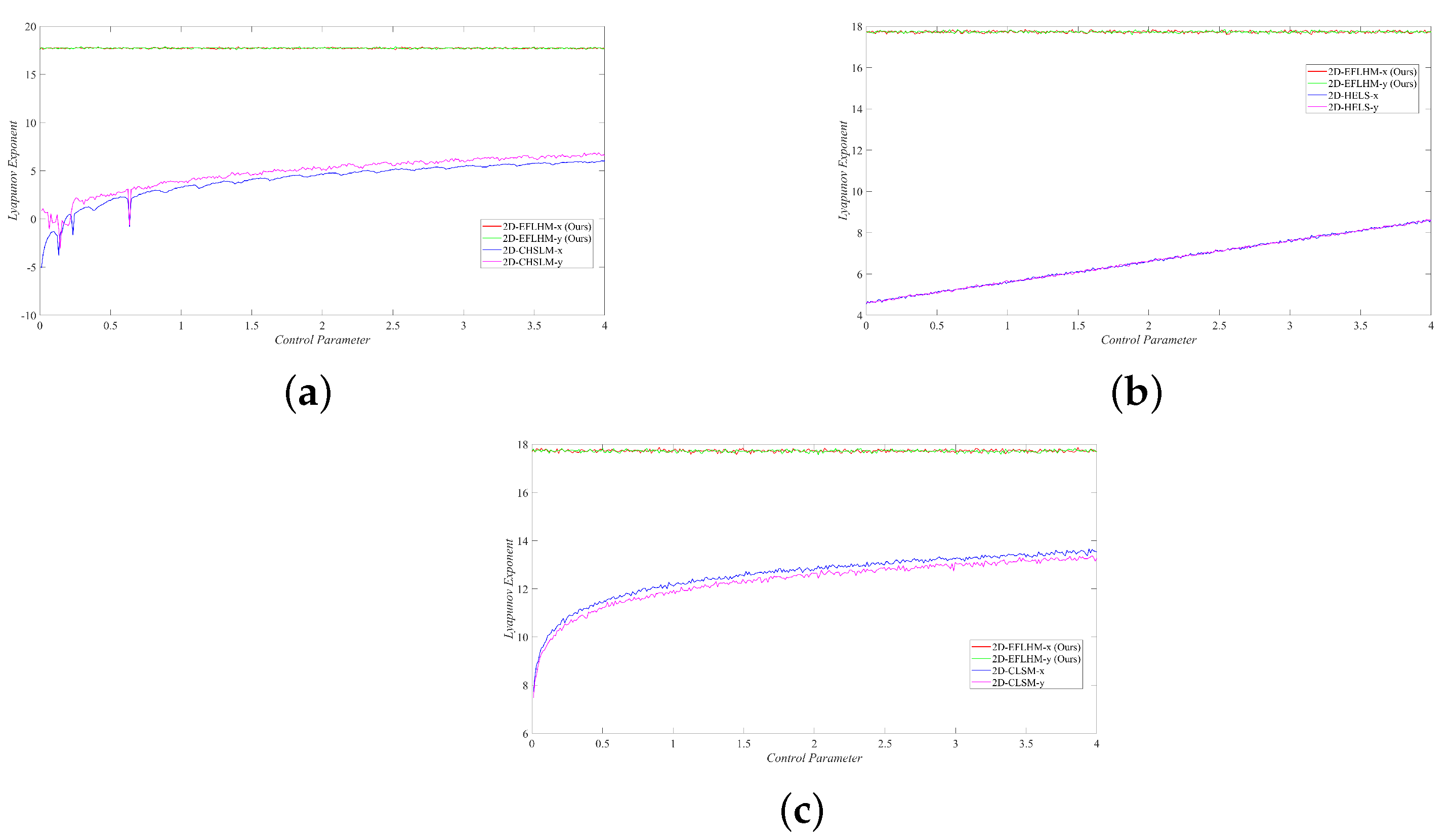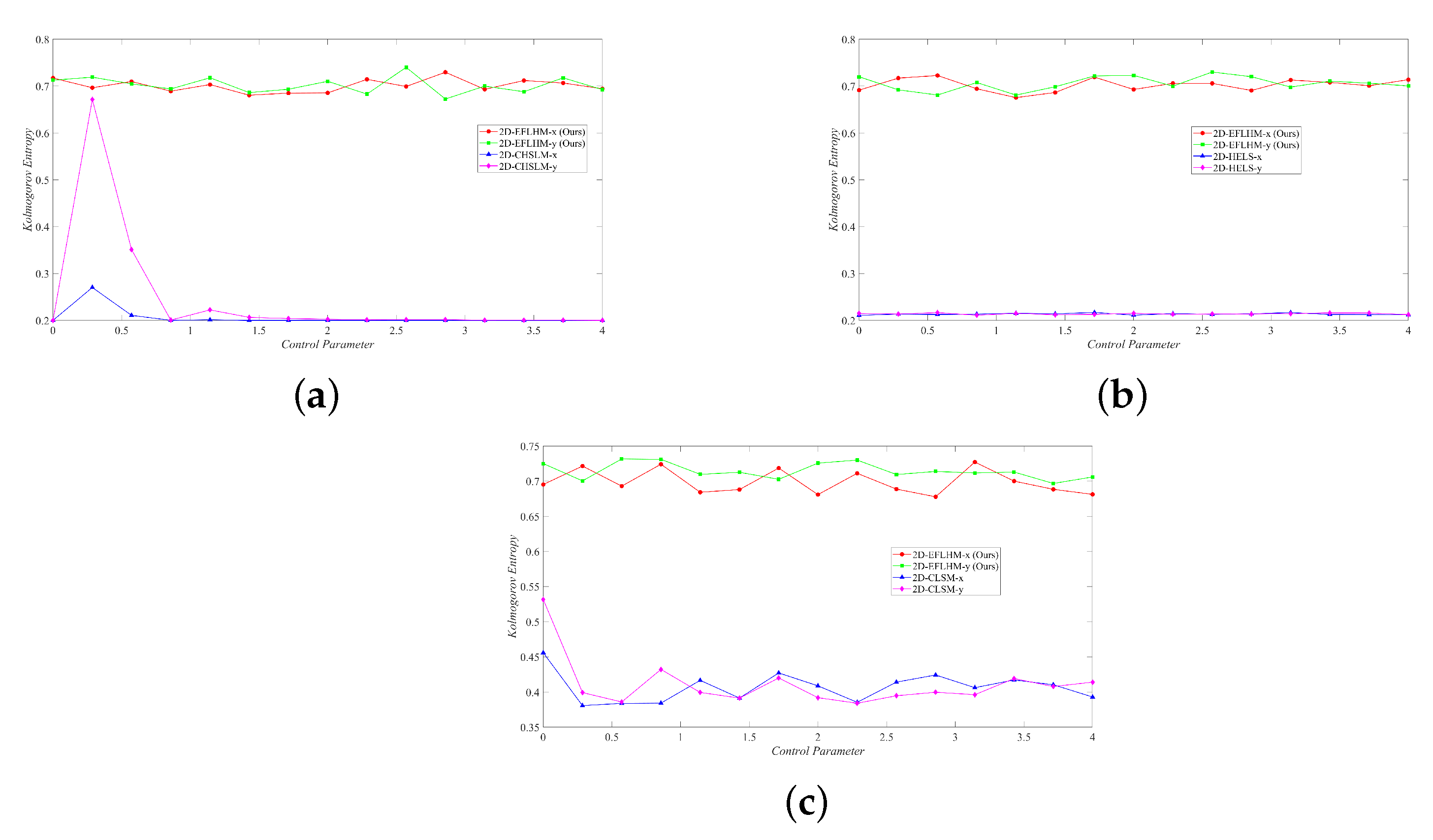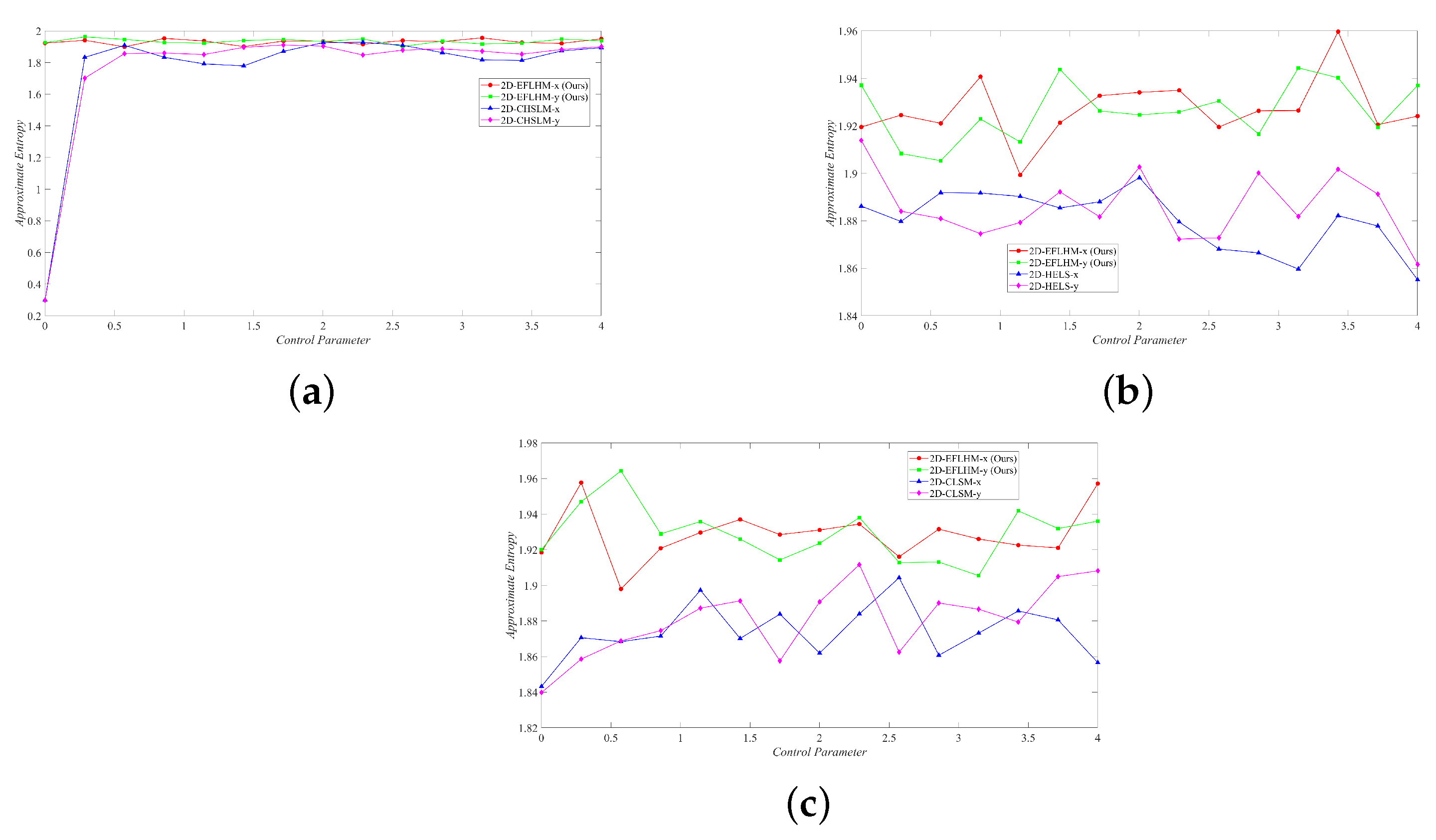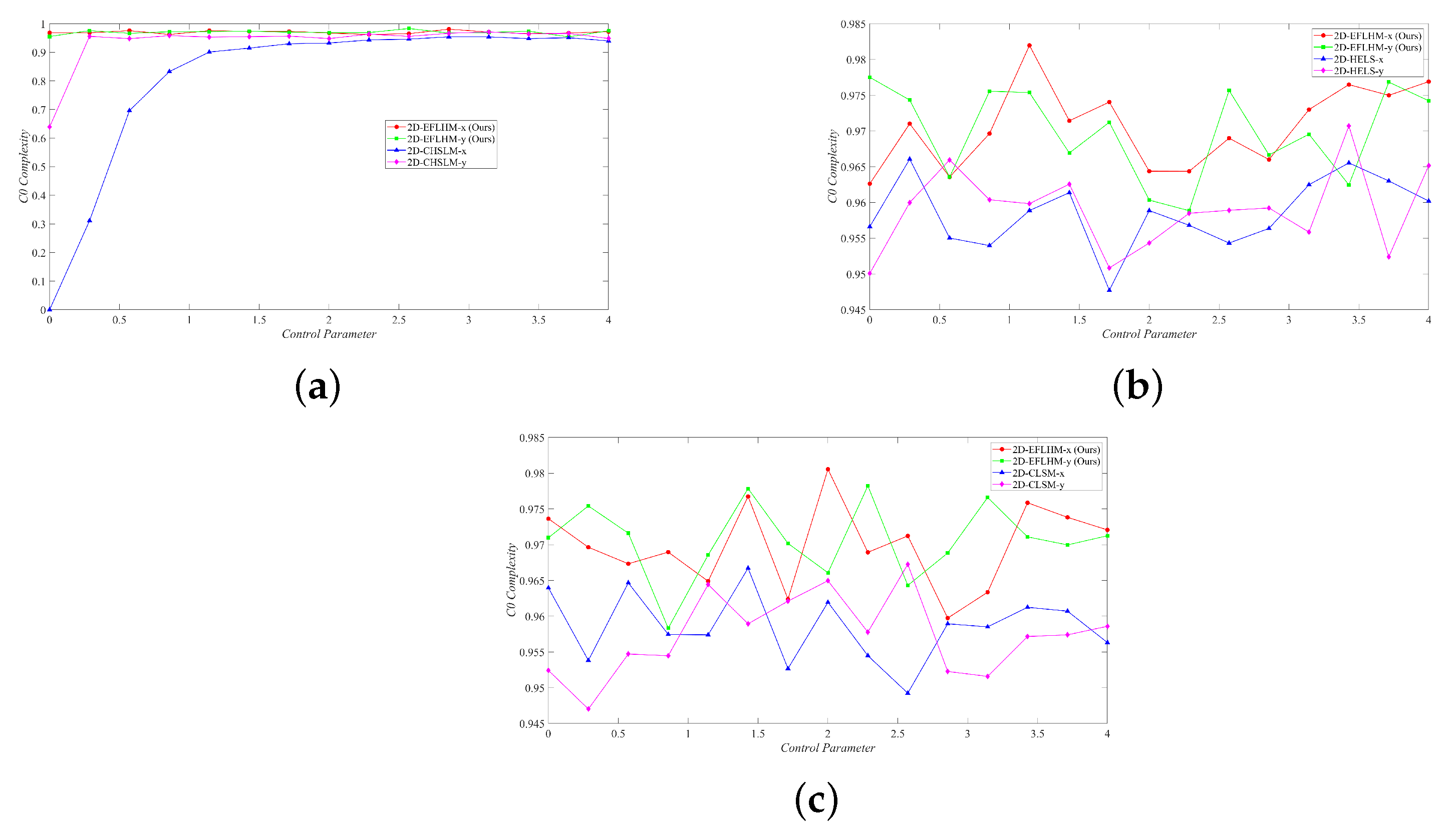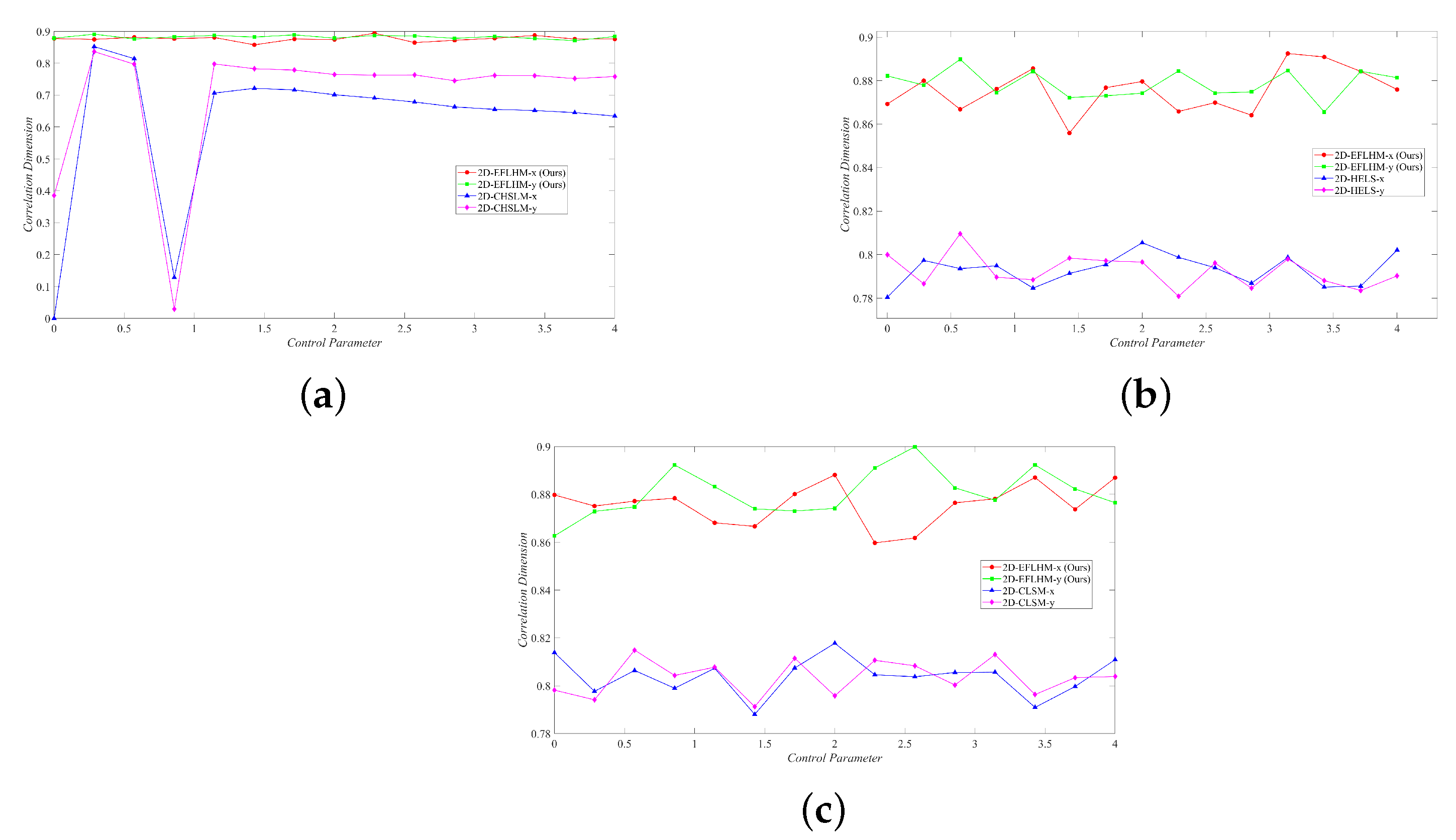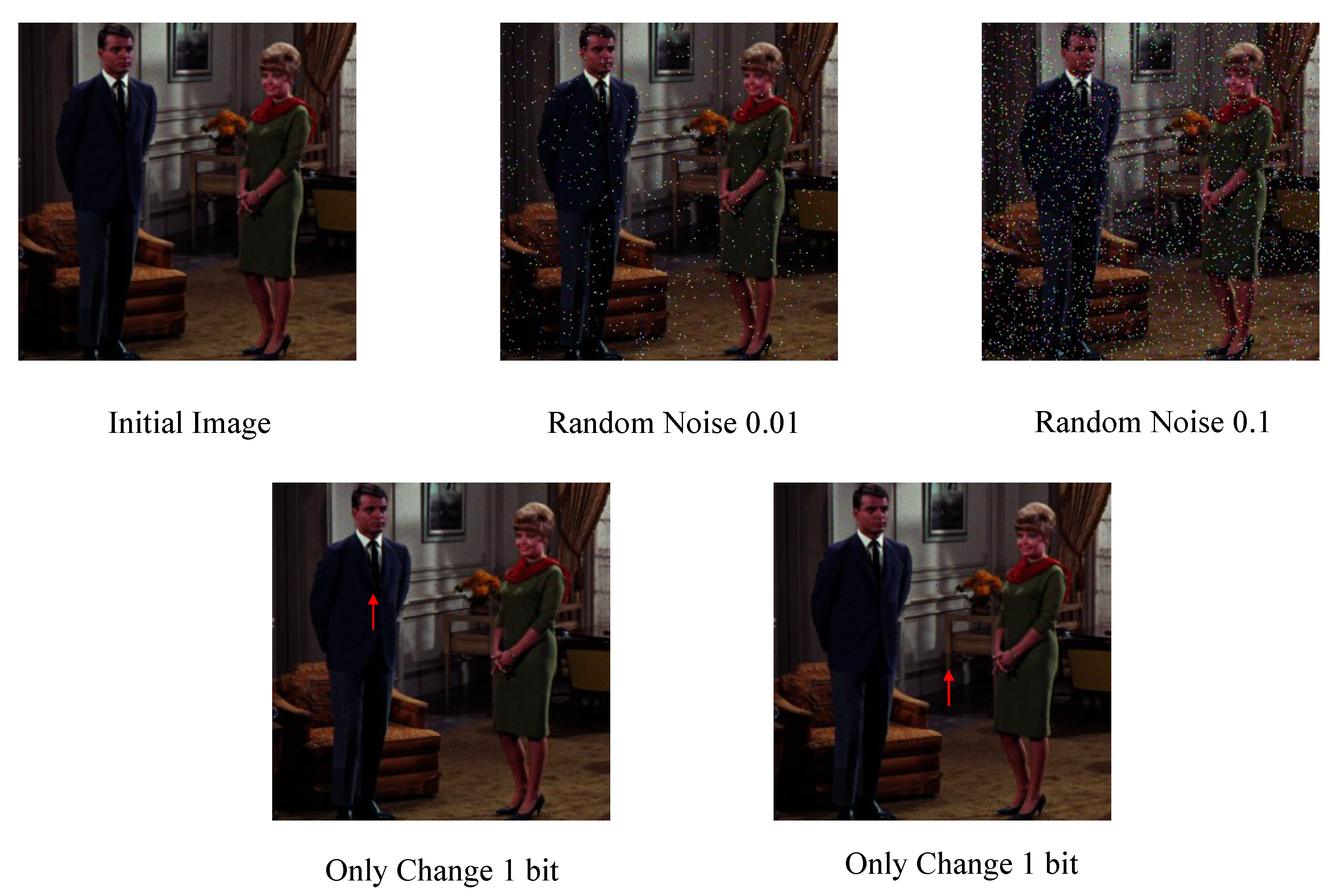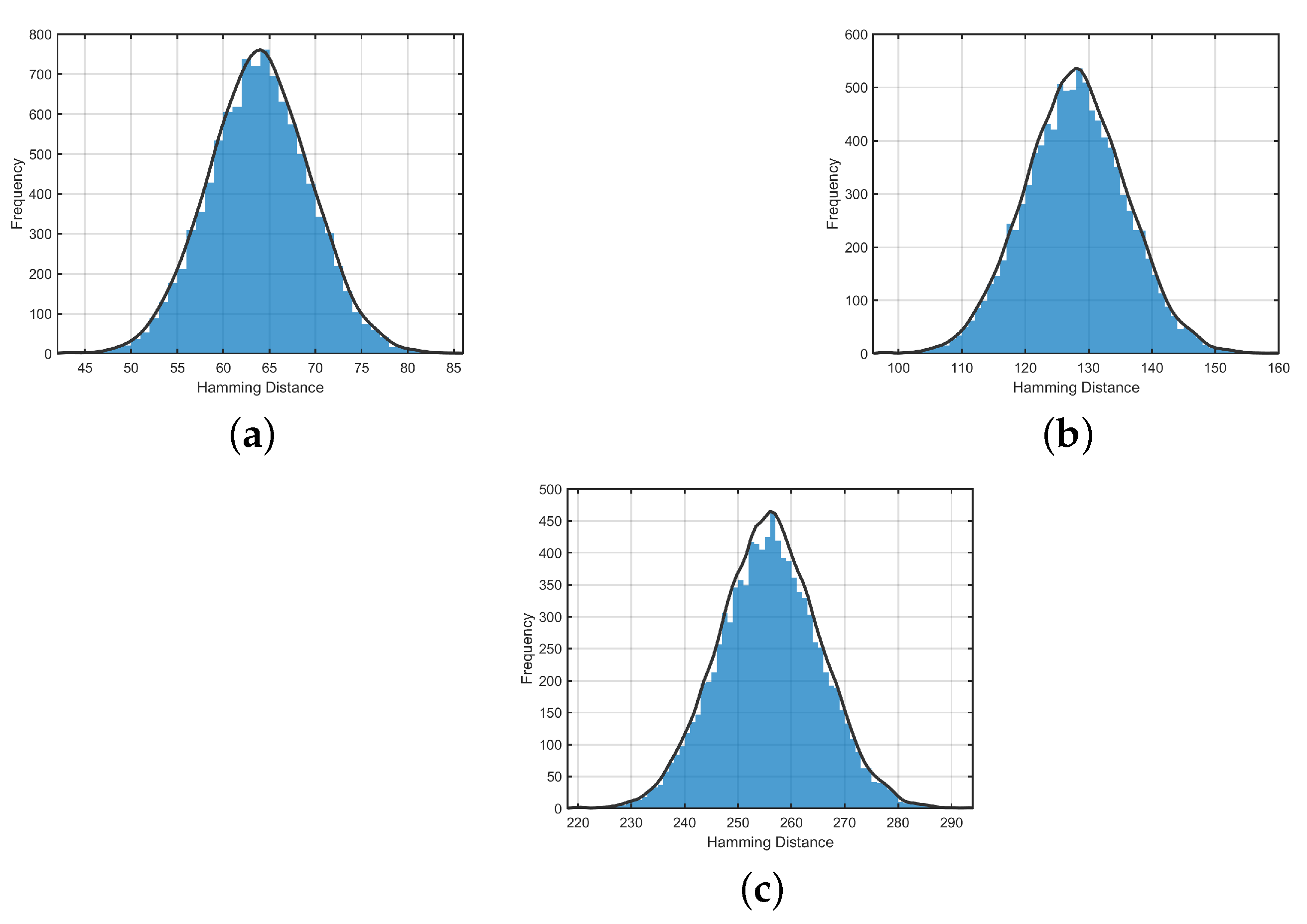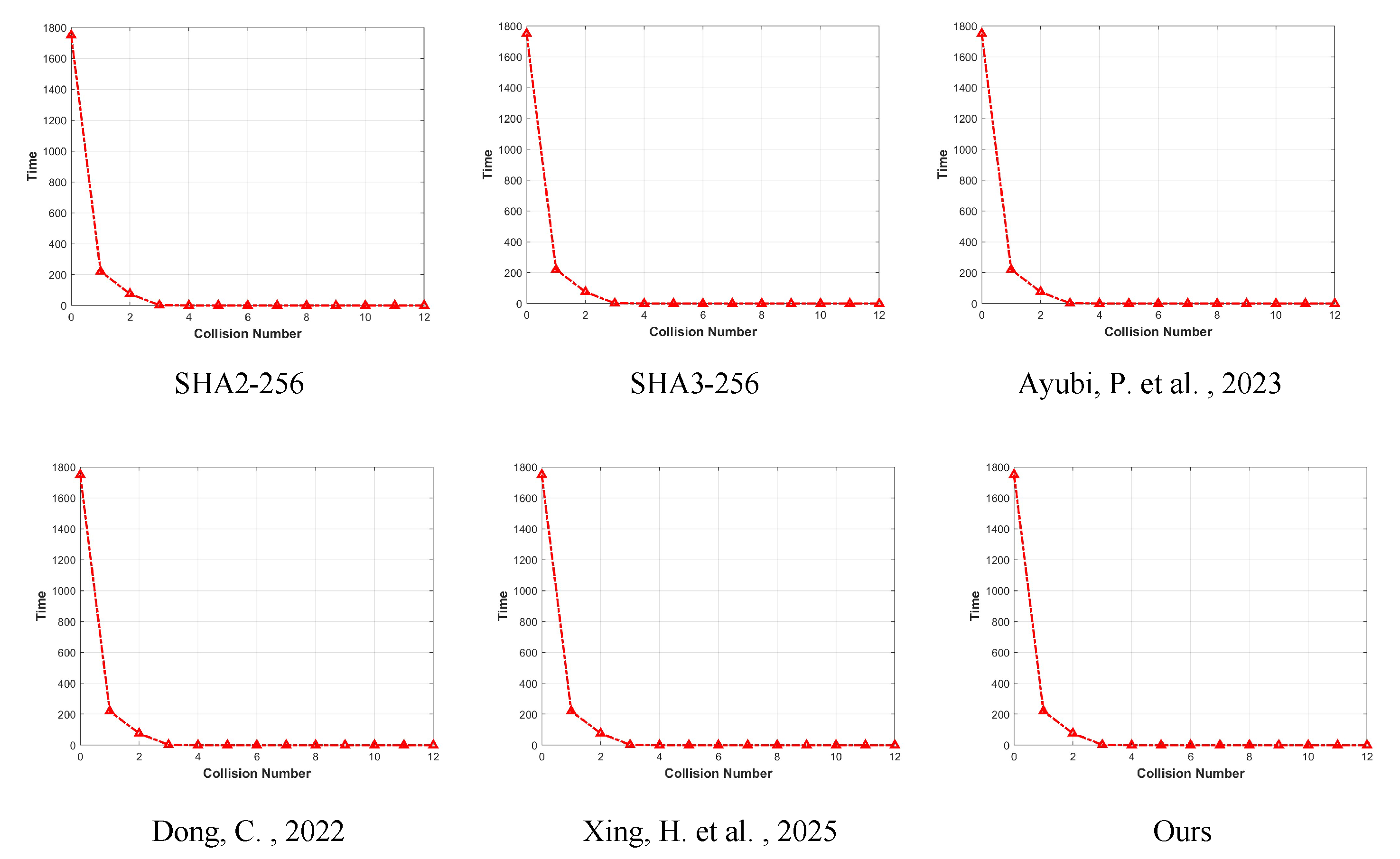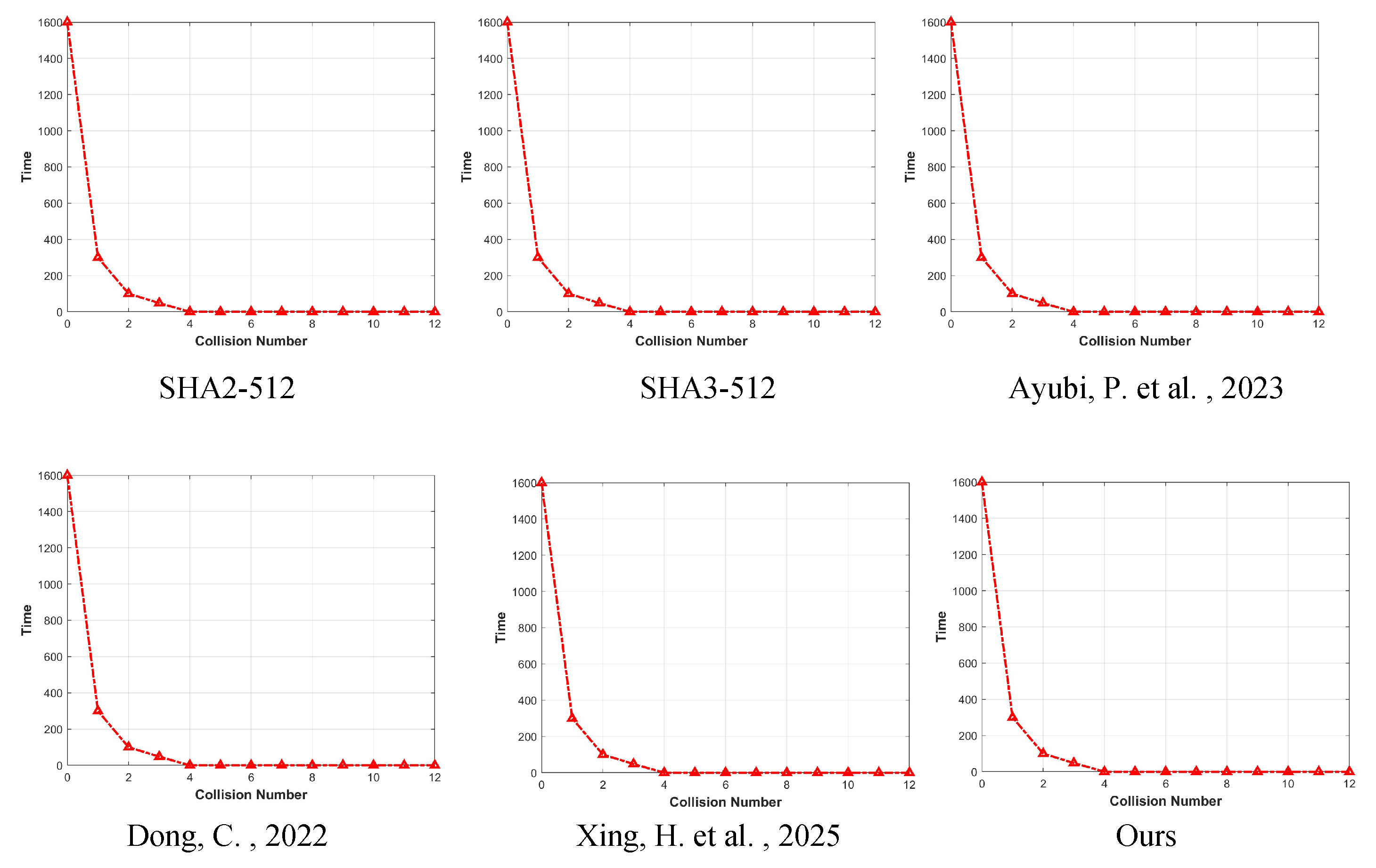1. Introduction
The cryptographic hash function encrypts data of arbitrary length irreversibly into data of fixed length [
1] and has important applications in the fields of message verification and digital signatures [
2,
3,
4]. At present, the widely recognized safe hash functions include SHA-2 [
5], which adopts block iteration, and SHA-3 [
6] which adopts a sponge structure. For image data, these hash functions deal with linearly stored data, and the processing speed is proportional to the number of pixel data. With the increase in image resolution, the computational complexity of hash function increases square, so it is necessary to seek a secure hash function dedicated to the specific needs for processing image data.
Chaotic system provides a new solution for many encryption scenarios, and high randomness can be achieved by simple operation. Chaotic systems are used to develop novel image encryption schemes [
7,
8,
9,
10,
11,
12], speech encryption schemes [
13,
14,
15], and secure communication schemes [
16,
17,
18,
19].
Figure 1 shows the bifurcation diagram of a part of traditional chaotic maps, from which it can be seen that there are problems of narrow chaos intervals and poor ergodicity. At the same time, traditional chaotic maps also show poor randomness; even after the systems completely enter the chaotic state, they will still produce false keys [
20]. In order to meet the needs of the image security hash function, we need more random, ergodic, and sensitive maps.
Hyperchaos exhibits positive Lyapunov exponents in multiple dimensions, thus being more sensitive to small perturbations and often exhibiting stronger complex chaotic behavior [
21,
22]. The construction of new hyperchaotic maps is a research hotspot at present. Wang et al. presented a novel two-dimensional cross hyperchaotic sine-modulation-logistic map (2D-CHSLM) aimed at enhancing image encryption schemes [
23]. The 2D-CHSLM can be mathematically defined as Equation (
1).
where
and
represent the state variables at iteration
n, while
r is a control parameter that influences the system’s chaotic behavior. (The symbols in Equations (
2) and (
3) have the same meaning). Wang et al. derived a novel chaotic two-dimensional hyperchaotic exponential adjusted logistic and sine map (2D-HELS) to enhance cryptographic applications [
24]. The 2D-HELS can be mathematically defined as Equation (
2).
Gao et al. proposed a novel two-dimensional cosine-logistic-sine map (2D-CLSM) aimed at addressing security shortcomings in existing image encryption schemes [
25]. The 2D-CLSM can be mathematically defined as Equation (
3).
These 2D hyperchaotic maps have greatly improved the performance of traditional chaotic maps. We hope to design a novel hyperchaotic map with more powerful performance by using nonlinear operations to further meet the needs of cryptography. In this study, we first design a new two-dimensional chaotic map and verify its superiority by using a variety of dynamic indicators and randomness tests. Based on the designed map, we propose a cryptographic hash function for image data and verify its excellent confusion diffusion characteristics and collision resistance. The main contributions of this paper can be summarized as follows:
A novel 2D nondegenerate hyperchaotic map with two ideal positive Lyapunov exponents is proposed, and Testu01 tests its sequence randomness over existing related works.
A special parallel cryptographic hash function for image data is designed based on 2D chaotic map, which ensures good security and exceeds the computational efficiency of existing general hash methods.
2. Proposed 2D Hyperchaotic Map
Constructing a highly cryptographically secure chaotic map requires the use of highly nonlinear operations. We select the structure of the classical Logistic chaotic map in the denominator and the structure of the existing work in the numerator. Sine operations, modulus operations, and remainder operations can achieve the stretching and folding of the motion trajectory of state points, ensuring the global bounded traversal of state variables [
26]. The combination of the two can effectively ensure that the system presents a nondegenerate hyperchaotic state within a sufficiently large control parameter range, has good ergodicity, and avoids the generation of local windows and weak keys.
Combined with exponential, fractional, and other nonlinear operations, we transform the classical logistic map and design a new type of chaotic map, which is mathematically expressed by Equation (
4):
where
are state variables. The control parameter
r is defined such that
and serves to modulate the dynamical characteristics of the system. We named it 2D Exponential Fractional Logistic Hyperchaotic Map (2D-EFLHM). The bifurcation diagram of 2D-EFLHM for two state variables is presented in
Figure 2, from which it can be seen that the system exhibits stable chaotic behavior.
We selected three specific control parameters to present its phase portraits, as shown in
Figure 3, showing complex attractor shapes and high-dimensional chaotic behavior and illustrating its applicability to the need for enhanced security and unpredictability.
We further conducted qualitative analysis to demonstrate the chaotic performance of the map. Random control parameters and initial state variables were selected, and minor disturbances were applied to the system. The sequence visualization is shown in
Figure 4. Even if there is a slight change in the initial state, the subsequent sequence will quickly undergo significant changes, thereby demonstrating the excellent chaotic characteristics of the system.
After the qualitative analysis, in this section, we illustrate the chaotic characteristics and randomness of the system through rigorous dynamic indicators.
2.1. Lyapunov Exponent Analysis
The Lyapunov exponent quantifies the average separation velocity of nearby orbits, and a positive value indicates that the corresponding dimension of the system enters a chaotic state; the larger the value, the faster the trajectory separation. In the dynamical system
, the mathematical definition of the Lyapunov exponent is given by Equation (
5) [
27].
Figure 5 shows that compared to other advanced chaotic systems, 2D-EFLHM has two positive Lyapunov exponents, and its value is higher, indicating that its chaotic behavior is more significant and stable.
2.2. Kolmogorov Entropy Analysis
Kolmogorov entropy estimates the complexity and chaos degree of a system by analyzing the relative distance changes between point pairs in phase space with different embedding dimensions. For a time series
generated by a chaotic map, its Kolmogorov entropy can be calculated by Equation (
6). It indicates different dimensions
d and small thresholds
that satisfy the distance being less than
, which is the logarithm of the ratio of the number of points to each other [
28].
Figure 6 shows the significant advantage of the 2D-EFLHM in terms of Kolmogorov entropy, indicating that its chaotic characteristics are higher and more suitable for application in the field of encryption.
2.3. Approximate Entropy Analysis
ApEn is a statistical test indicator that measures the unpredictability of a time series, reflecting the likelihood that similar patterns in a time series will remain similar in the next state. For a time series
, a sequence length
m, and a tolerance threshold
r, the sample entropy of ApEn can be calculated as follows [
29]:
Figure 7 shows that the 2D-EFLHM also achieved competitive results in terms of Apen, with slightly higher values than other systems as the control parameters changed, indicating that the time series it generates is more difficult to predict.
2.4. Complexity Analysis
complexity reflects the complexity of the system by assessing the volatility, which can be calculated as follows:
where
is the mean of the entire series, and
M is the total number of segments of length
L [
30].
Figure 8 compares the
complexity of our designed 2D-EFLHM with that of other works, indicating that in the whole range of control parameters, 2D-EFLHM presents an ideal positive value, and its sequence is complex and difficult to predict, showing good pseudo-randomness.
2.5. Correlation Dimension Analysis
The correlation dimension provides the dimension information occupied by the attractor in the phase space of a chaotic system and is a measure to quantify the fractal structure and complexity of the chaotic attractor. A higher value indicates more complex and higher-dimensional chaotic dynamic behavior [
31]. The correlation dimension is denoted as
D and can be calculated as follows:
where
N is the total number of embedded vectors, and
r is the set small threshold.
Figure 9 shows that the designed 2D-EFLHM has a stable and higher correlation dimension, indicating that it has more complex fractal attractors and dynamic behaviors and exhibits stronger chaotic characteristics.
2.6. Randomness Analysis
For cryptographic applications, the randomness of the mapping is a more important index. Testu01 is a widely recognized rigorous randomness testing tool, which is divided into small crush, crush, and big crush according to the difficulty of testing [
32]. We randomly selected the initial value and effective control parameters of maps, multiplied the resulting chaotic sequence by a gain, and then tested its randomness, and the results are shown in
Table 1.
Compared to the other maps, the designed 2D-EFLCM has fewer test failures and more stable high randomness under various conditions.
5. Conclusions
We constructed a nondegenerate hyperchaotic map 2D-EFLHM whose sequence randomness surpasses many similar works and exhibits excellent synthetic chaotic characteristics. Based on the powerful performance of 2D-EFLHM, we designed an image-specific hash function, which has excellent confusion diffusion performance, randomness and collision resistance, and which can resist many common attacks.
The designed hash function is highly suitable for processing high-resolution image data and is suitable for the primary usage scenarios of computing resources. However, the implementation of the chaotic map is based on computer floating-point simulation, so its application in the case where Ethereum smart contracts only support integers and fixed-point numbers will be limited. Future work could explore the application of 2D-EFLHM to other cryptographic domains and could also focus on specialized hash functions for other multimedia data.



